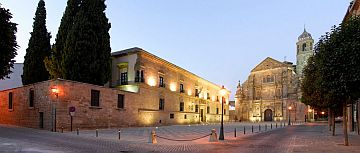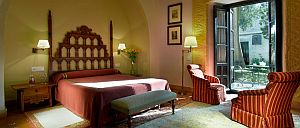
Ubeda, Andalusia, SpainThis part of Spain had been occupied by the Romans and Visgoths, although only 10km from Ubeda recent digs have uncovered evidence of a pre-Roman settlement. Ubeda became quite an important town whilst the Moors had control of it, and when King Ferdinand III eventually re-captured it from the Arabs in the early 13th century the Jews, Christians, and Muslims co-existed quite amicably. Ubeda continued to be significant because of its location being on the border between Granadaand Castile-La Mancha. Unfortunately, there was great rivalry amongst the local nobility and civil war eventually broke out during the 14th century destroying much of the town. Thankfully by the 15th and 16th century everything had settled down again and, due to the number of prominent people who built their magnificent homes in Ubeda, the town was able to flourish once more.  In contrast to the white walls and romantic courtyards of most other buildings in Andalucia, Ubeda's monuments were made from granite, so they have a more austere presence. The town's most impressive feature is the Plaza de Vazquez de Molina which is lined with stunning Renaissance palaces such as the Palacio de las Cadena and the Palace of Constable Davalos which has been converted into a Parador. Being right in the heart of the historic quarter, the Parador Ubeda (Hotel Condestable Davalo) is a perfect base. It is beautifully decorated with an elegant inner courtyard, provides a friendly and comfortable atmosphere, and some of the bedrooms actually overlook over the Plaza de Vazquez de Molina itself.
In contrast to the white walls and romantic courtyards of most other buildings in Andalucia, Ubeda's monuments were made from granite, so they have a more austere presence. The town's most impressive feature is the Plaza de Vazquez de Molina which is lined with stunning Renaissance palaces such as the Palacio de las Cadena and the Palace of Constable Davalos which has been converted into a Parador. Being right in the heart of the historic quarter, the Parador Ubeda (Hotel Condestable Davalo) is a perfect base. It is beautifully decorated with an elegant inner courtyard, provides a friendly and comfortable atmosphere, and some of the bedrooms actually overlook over the Plaza de Vazquez de Molina itself.
The 16th century hospital has since been converted into the town's Conference Hall but also worth a look, with its square bell towers and lovely inner courtyard. There are also dozens of examples of religious architecture throughout the town, in particular the Church of Santa Maria de los Reales Alcazares which was built on the site of an old Arab mosque, and the Capilla del Salvador where many of the nobility were buried. If you wish to buy some local handicrafts make your way to the Calle Valencia which leads off the Plaza de Vazquez de Molina, as this is where most of the craftsmens' studios are found. Also of interest is the potters' quarter where you can buy pottery made of the traditional deep green glaze. Beyond Ubeda there are several interesting sites to visit and all within easy reach, such as the prehistoric paintings in the Graja Caves at Jimena. The drive along the Renaissance Route will take you though some charming historical cities such as Jaen and Baeza which neighbours Ubeda and has equally magnificent examples of Renaissance architecture. For nature lovers, the province of Jaen has the largest number of protected areas of natural beauty in Andalusia, and the Carzola National Park for example is absolutely stunning in the autumn. Each year at the end of May Ubeda hosts an International Music and Dance Festival that includes jazz and classical music, as well as flamenco and many other forms of dance. The town's main festival is held in September, the San Miguel, which means both spring and autumn can offer an extra element of entertainment during your stay in Ubeda. |